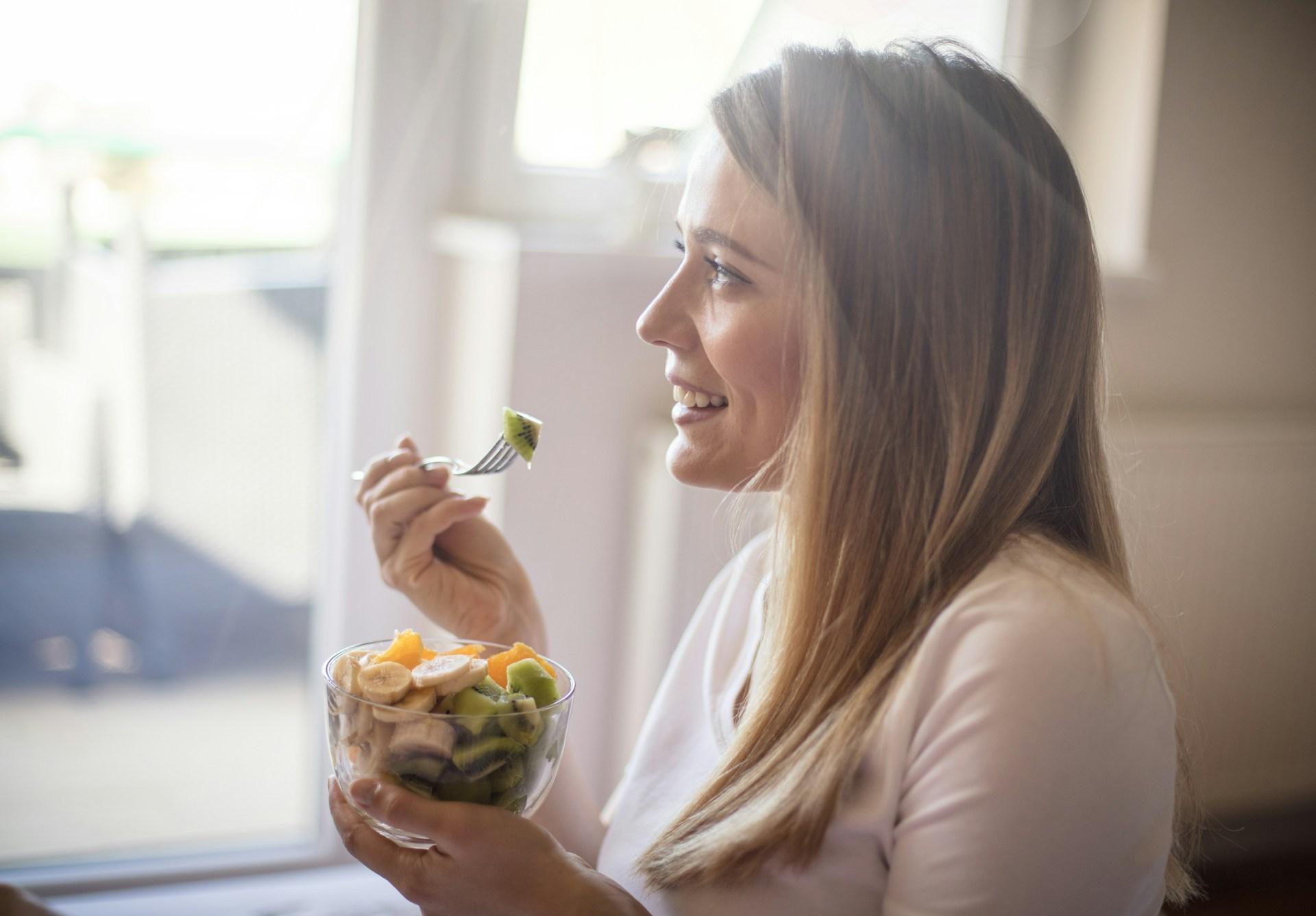Fiber is an essential part of a healthy diet, yet 95% of the U.S. population is not consuming enough. In honor of Fiber Awareness Month and Heart Health Month, I’m going to give you the scoop on what fiber is and why it’s so important for your health. I’ll also share one of my favorite easy sheet pan recipes that will help you meet your fiber goals in the most delicious way possible.
What is Fiber?
First things first, you may be wondering: what is fiber anyway? Fiber is an indigestible carbohydrate found primarily in fruits, vegetables, legumes, nuts and seeds, and whole grains.
The two types of dietary fiber are soluble and insoluble. Soluble fiber dissolves in water and increases feelings of fullness, supports weight loss, lowers cholesterol levels, and reduces blood sugar levels after eating. Good sources of soluble fiber include foods like chia seeds, black beans, lentils, peas, and some fruits (i.e. apples, oranges, pears, etc.) and vegetables (i.e. carrots, broccoli, beets, etc).
Insoluble fiber does not dissolve in water and is known to add bulk to the stool, promoting regular bowel movements and supporting overall digestive health. Good sources of insoluble fiber include foods like wheat bran, potatoes, almonds, and whole-grain bread or pasta. It’s ideal to get your fiber from whole foods rather than fiber supplements when possible, but your registered dietitian (RD) can help you determine the best fiber sources for you.
What are the Health Benefits of Fiber?
You may have heard that foods with high fiber content help “keep things moving” in the digestive system, and while that’s true, its health benefits extend beyond gut health. Research shows fiber can help reduce your risk of chronic diseases such as heart disease, diabetes, obesity, inflammatory bowel disease, and colorectal cancer. Fiber also supports heart health, sustainable weight loss, and promotes stable blood sugar levels.
Heart Health
Eating more fiber is a great way to support your heart health and help prevent cardiovascular disease. Soluble fiber helps lower LDL cholesterol by binding to cholesterol particles and removing them from the body. Some studies also suggest that a high-fiber diet can help lower blood pressure.
Digestive Health
Dietary fiber is a prebiotic that supports overall digestive health by promoting healthy gut bacteria growth. In addition to supporting regular bowel movements, a high-fiber diet can also reduce your risk of developing colorectal cancer and diverticulitis.
Weight Loss and Management
The reason that high-fiber foods support weight loss is multifactorial. Boosting dietary fiber intake helps to increase satiety (helping us to feel full and satisfied). Since we can’t fully break fiber down in the body because it’s indigestible, we extract a negligible amount of calories from it, so it helps with calorie control. Additionally, high-fiber foods are typically nutrient-dense, whole foods that support overall health and weight loss.
Blood Sugar Control
Soluble fiber helps slow down sugar absorption, which helps regulate blood sugar levels in the body. Incorporating more fiber into the diet can reduce your risk of developing prediabetes or diabetes. If you’re already living with type 1 or type 2 diabetes, fiber can help keep your sugar levels within range.
How Much Fiber Should You Eat Every Day?
According to the Academy of Nutrition and Dietetics’ dietary guidelines, the daily recommended fiber intake for people assigned female at birth is 25 grams and 38 grams for people assigned male at birth. Your exact needs may vary based on your health goals and factors such as age, sex assigned at birth, physical activity levels, and health conditions.
If you’re not eating this much fiber right now, don’t worry. You should aim to gradually increase your daily fiber intake while also increasing your water intake. This will help reduce any digestive discomfort you may experience from the added fiber. If you need help incorporating more fiber into your diet, a registered dietitian can work with you on a personalized nutrition and lifestyle plan.
Recipe: High-Fiber Meatball Sheet Pan Dinner
If preparing nutritious dinners every night feels overwhelming, we’re here to help! Our healthy, fiber-rich sheet pan dinner made of turkey meatballs and veggies couldn’t be easier to whip up. It only requires two pans, 10 minutes of prep, and minimal chopping since most of the veggies are pre-cut or frozen.
While meatballs are traditionally made with breadcrumbs, we used oat flour for this recipe. Why oat flour? Because oats are an incredible source of soluble fiber and resistant starch. Both support a healthy gut microbiome, which is essential to our overall health.
Check out the other health benefits of each ingredient below.
Turkey
It’s important to include a significant source of protein at every meal to keep you full and help maintain lean body mass. In this recipe, we used turkey as the main protein. Not only is turkey high in protein, it also boasts an impressive nutrient profile. It provides a significant amount of niacin, vitamin B-12, and selenium — all of which are essential vitamins and minerals.
Selenium, in particular, is a mineral that doesn’t receive much attention but plays a vital role in our metabolic health. The thyroid needs selenium to produce thyroid hormones. Thyroid function and hormones greatly impact our metabolic rate. Eating enough selenium-containing foods, like turkey, can help prevent thyroid issues related to selenium deficiency.
Cauliflower rice
We know, we know — cauliflower has been having a moment — but there’s a reason for that! Cauliflower is a versatile vegetable, not to mention it’s packed with health-promoting nutrients and non-nutrients (like antioxidants).
Just to be clear, cauliflower rice is not made with actual rice. It’s simply cauliflower that manufacturers cut into a rice-like shape to mimic the mouthfeel of real rice. That’s why cauliflower rice is such a great swap for regular rice — especially for people wanting to lose weight.
That’s because cauliflower rice is higher in fiber and lower in calories than both cooked white rice and brown rice. In fact, 100 grams of cauliflower rice contains 24 calories, whereas 100 grams of cooked brown rice contains 122 calories. Put simply, you could eat about five times as much cauliflower rice than cooked brown rice for the same amount of calories.
This is helpful for weight loss because when we eat a large volume of food, it physically stretches our stomach and sends a signal to our brain that we are full. Research has shown that eating high-fiber, low calorie foods can help with weight loss.
Sweet potatoes and carrots
Seeing lots of orange in the photos of this recipe? That’s the beta-carotene in the sweet potato wedges and carrot slices. Beta-carotene is actually a pigment found in plants that gives them their bright color. When we consume beta-carotene in foods, the body converts it to vitamin A. Vitamin A then acts as an antioxidant, helping to combat inflammation. Pretty cool, right?
- 1 lb ground turkey lean
- 2 eggs
- 1 tsp kosher salt
- 1 cup oat flour
- A few pinches black pepper
- 1 tsp garlic powder
- 1/2 tsp ground cumin
- 1/2 tsp red pepper flakes
Veggies
- 10 oz. grape tomatoes whole
- 2 cups carrot chips
- 1 cup sweet potato cut into 1/8th wedges
- 2 cups riced cauliflower frozen
- 2 tbsp extra virgin olive oil
- 1 tbsp tahini
- 1 tsp garlic powder
- salt and pepper to taste
Dressing
- 2 tbsp hummus
- water
- lemon juice
2 sheet pans
2 large bowls
Combine all the ingredients for the turkey meatballs in a large bowl. Using your hands, mash together until the mixture is uniform throughout. Do not overmix.
Lay foil over baking sheet #1 and spray with cooking spray. Then, form 16 equally sized meatballs with hands and place onto tray.
Place the tray of meatballs in the freezer for about 15 minutes.
While the meatballs are chilling, preheat the oven to 425° F.
Combine all veggie ingredients in one large bowl. Ensure that olive oil, tahini, and spices evenly coat all the veggies.
Lay foil over baking sheet #2 and spray with cooking spray. Dump the bowl of veggies onto tray and spread out, ensuring one even layer.
Take the meatball tray out of the freezer. Once oven is preheated, put both pans into the oven.
Cook for approximately 40 minutes, until veggies are soft and meatballs are cooked all the way through. At minute 20, bring the top rack pan to the bottom rack, and the bottom rack pan to the top rack.
Let cool for several minutes. While cooling, put hummus in a small dish. Combine with a small amount of water and/or lemon juice to thin into a dressing consistency.
Plate each serving with a handful of greens (optional) and drizzle hummus dressing over the meatballs and veggies.
Want more easy recipes like this one? Download our sheet pan meal guide for ideas on how to create your own high-fiber sheet pan meals.
Work With a Culina Health Dietitian
Need help increasing your fiber intake? Meet with a Culina Health dietitian. Our team provides personalized clinical nutrition care to help people like you achieve their health and wellness goals. Book a session today.








